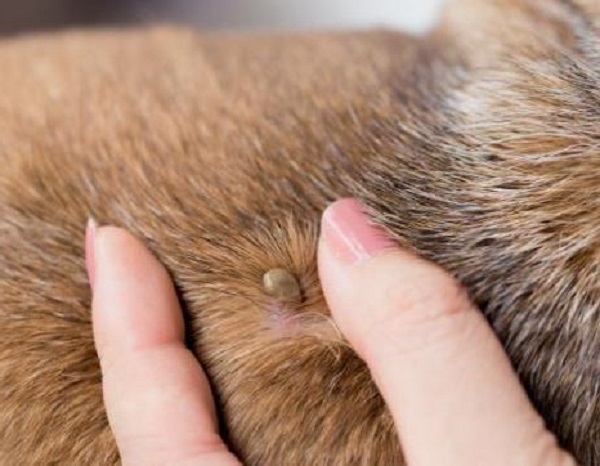Starting the process of protecting your dog against ticks is an important part of being a good pet owner. We explore the topic of ticks in dogs in this in-depth guide, including crucial elements like detection, prevention, and treatment advice. Discover the unnerving truth about tick infestations, the right methods for getting rid of them, and preventative ways to avoid these bothersome parasites. With our in-depth analysis of ticks in dogs, you can arm yourself with information to protect your pet’s health.

Ticks: what are they?
Misunderstood as insects, ticks are really members of the arachnid family, which also includes mites, spiders, and scorpions. Unlike insects, which usually have six legs and two antennae, these small arachnids are distinguished by having eight legs and no antennae.
Ticks are bloodsucking parasites that prey on people and pets among their host populations. Their extraordinary capacity to cling firmly throughout the blood-feeding process is the foundation of their effectiveness as disease carriers. Ticks, in contrast to insects, have a sluggish feeding cycle that may last for many days, which enables them to remain undetected for a long time.
By realizing that ticks are just blood-feeding, persistent arachnids, we may better appreciate the hazards that these insects may represent as disease vectors and the significance of efficient preventive and removal techniques.
What Causes Ticks in Dogs?

As opportunistic parasites, ticks are highly attracted to motion and warmth and use these indicators to determine whether a warm-blooded host is present. Ticks might potentially meet dogs in the following circumstances when searching for a blood meal:
- Wandering into Vegetated Areas: Ticks engage in a behavior known as “questing,” when they deliberately place themselves in thick grass, forested areas, or bushes. Ticks wait eagerly in these places for the chance to attach themselves on passing hosts.
- Visiting animals Hotspots: Dogs that spend time in locations where deer or other animals congregate run the danger of coming into contact with ticks. These places act as hotspots where ticks may readily attach themselves to gullible hosts.
- Outdoor Exploration in the Warmer Months: Dogs who move freely are more likely to come into contact with ticks, especially in the warmer months of the year when outdoor activities are more common. There is a greater likelihood of tick interactions and bites due to the increased outdoor activities.
Signs of tick infection in dogs
Tick identification on your dog is a tactile procedure since these parasitic opportunists often hide in dark or hairless places. Gently run your fingers through your dog’s fur to check for ticks, being on the lookout for any lumps or bumps that don’t seem normal.
frequent early symptoms of tick-borne illnesses that are frequent in the United States include Rocky Mountain spotted fever, Lyme disease, and tick paralysis. Fever and tiredness are generally the main symptoms. Additional symptoms, such as weakness, lameness, joint swelling, or anemia, may appear depending on the particular tick-borne infection. A first awkward walk in tick paralysis instances might lead to complete paralysis.
It is important to understand that tick-borne illness symptoms may not appear right away. Certain symptoms may not show up for days, weeks, or even months. As a result, it’s essential to regularly check your dog for ticks and to pay closer attention to any changes in their health, particularly if they’ve been in areas where ticks are common. Tick infections in dogs are best managed and treated with early discovery and quick veterinarian intervention.
Symptom
- Scratching: Excessive scratching or itching, especially in localized areas.
- Presence of Embedded Ticks: Detection of brown or black ticks embedded in the skin, varying in size from approximately a millimeter to the size of a marble.
- Skin Bumps: Formation of raised bumps on the skin surface.
- Crusty Spots or Scabs: Appearance of crusty spots or scabs on the skin, indicating potential tick bites.
- Red Spots or Bullseye-Shaped Red Circles: Development of red spots or distinctive bullseye-shaped red circles on the skin.
- Fever: Elevated body temperature beyond the normal range.
- Lethargy: Unusual fatigue or lack of energy.
- Weakness: Decreased strength or stamina.
- Joint Swelling: Swelling in the joints, potentially indicating a tick-borne illness.
- Anemia: Reduced red blood cell count, leading to weakness and fatigue.
- Clumsiness: the gradual onset of a clumsy gait, which may progress to more severe mobility issues.
How to Treat Ticks
The first step in treating ticks is to safely remove them by using the right extraction techniques; pet owners may handle this chore. Getting your dog checked out by a veterinarian right away is crucial if it exhibits signs like a fever, lethargy, or limping. Lyme disease and other tick-borne infections may be treated with antibiotics; with early treatment, symptoms usually resolve within a few days. In many cases, extended antibiotic usage is required to completely eradicate infections. Kidney injury is one example of a complicated condition that may need for extensive hospital stays and supportive treatment.
For tick paralysis, removing ticks promptly typically resolves symptoms within 24 hours, as the underlying cause lies in neurotoxins present in the tick’s saliva. In rare cases, dogs experiencing breathing difficulties may receive supplemental oxygen. Swift and proper tick treatment are key to ensuring your dog’s health post a tick encounter.
How to Take Out a Dog’s Tick

You need to take quick action if you’re wondering how to remove a tick from your dog. The best approach is to use tweezers or instruments made specifically for removing ticks. Take the actions listed below to remove ticks properly:
- Use a tick removal instrument or tweezers.
- Snatch the tick up close to your dog’s skin, just at its mouthparts.
- Prevent applying pressure to the tick’s body by gently twisting and lifting it away from the skin.
- Once removed, safely place the tick in an airtight container so your veterinarian can identify it.
How to Avoid Bite From Ticks
If you live in an area where ticks are common, you should take preventative precautions to safeguard your dog. Here’s how to keep your dog safe from tick bites:
- Frequent Checks: Make sure your dog is thoroughly checked for ticks after any outside activities, especially in forested areas. Examining their ears, fur, and other concealed places is part of this.
- prophylactic Medicines: Look into using oral or topical tick-repelling prophylactic drugs. See your veterinarian to find the best and most efficient course of action for your dog.
- Tick-Repellent Collars: To further guard against tick bites, think about putting on a tick-repellent collar.
- Maintain Yard Hygiene: Take good care of your outside space. Reduce the possibility of ticks in your dog’s immediate environment by keeping the yard well-mowed, removing tall grass, and erecting obstacles.
- Minimize forested Adventures: When enjoying the great outdoors, keep in mind that forested regions are more likely to harbor ticks. To reduce exposure, think of other ways or routes.
- Quick Removal: Using tweezers or a tick removal instrument, remove ticks as soon as possible and gently. Adhere to appropriate extraction protocols in order to reduce the potential for disease transmission.
FAQs about Ticks on Dogs
When my dog gets ticks, what should I do?
Take quick action if you discover ticks on your dog. To remove them gently, use tweezers; save the tick for identification; and get advice from your veterinarian. To prevent future exposures with ticks, keep a watchful eye on your dog’s health and talk to your veterinarian about prophylactic treatments. It’s critical to take prompt, well-informed action for your dog’s health.
